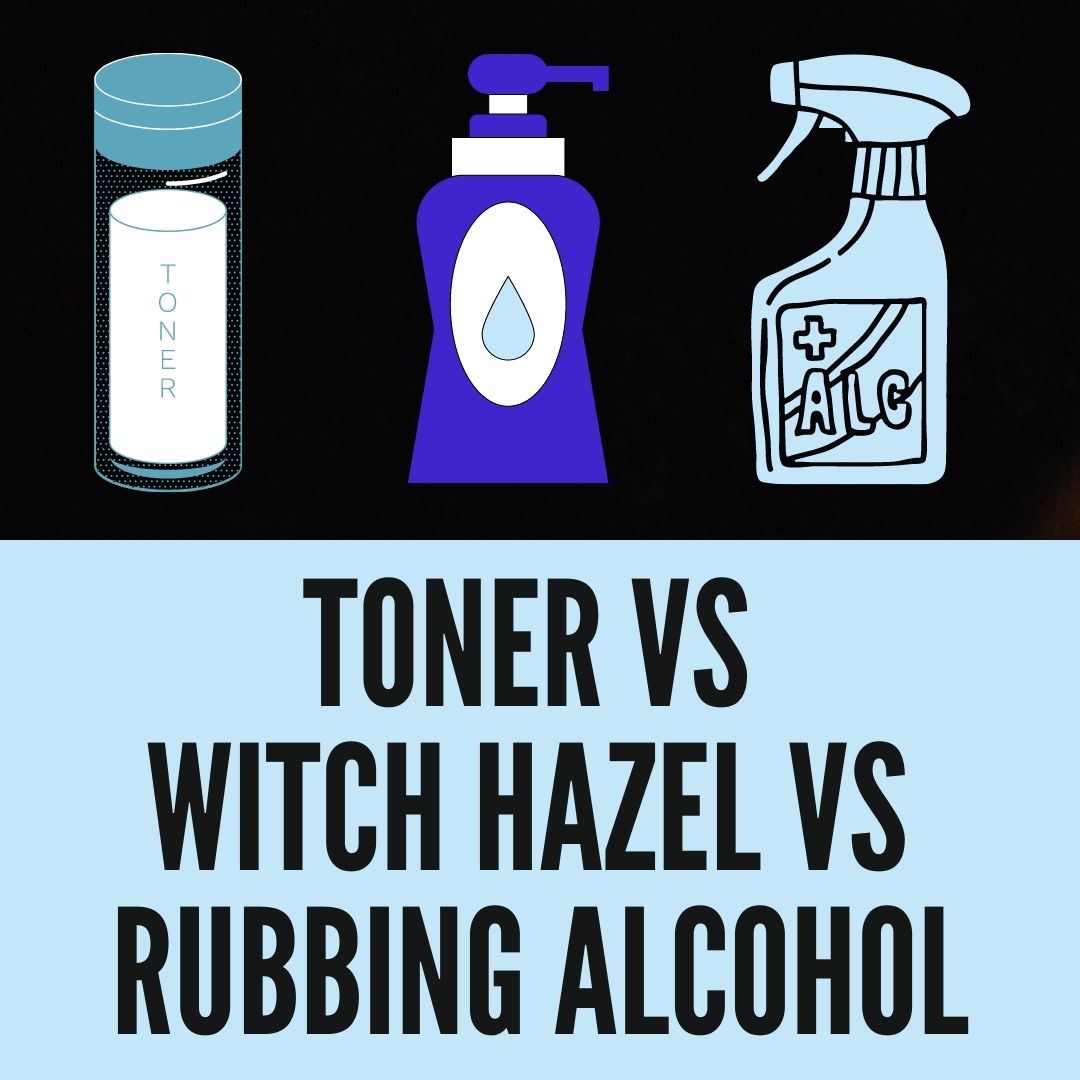
On many occasions, you may have read tips that suggest using Witch Hazel instead of Rubbing Alcohol.
Or maybe some skincare pro in amongst your friends and family suggested you switch Toner with Witch Hazel. Is it really safe and worth it? Come, let’s put some light into it together.
What is Witch Hazel?
Witch Hazel is a plant with three species commonly found in North America. They are occasionally also known as Winter blooms. Two common Witch Hazel plant species are also found in China and Japan (one each).
Witch Hazel is basically a shrub that has been popular for its usage in a variety of skin ailments for centuries.
It has several uses and benefits, from fighting acne and pimples to treating burns, hemorrhoids, inflammation, insect bites, and bruises.
Due to its endless benefits, Witch Hazel commonly comes in handy as an active ingredient in toners and several other skincare products.
Is Witch Hazel and Rubbing Alcohol the same?
Today when you step out to your local drugstore, you can easily find Witch Hazel in its pure form. If you are a first-time buyer and not familiar with the difference, you may confuse Witch Hazel with Rubbing Alcohol.
It is because bottles and liquid of both the solvent appear out to be quite similar. However, in reality, Witch Hazel and Rubbing Alcohol aren’t the same liquid.
- NEW LOOK, SAME TONER FORMULA: Alcohol-free and formulated to soothe, tone, hydrate, and balance the pH level of skin; This gentle face toner helps reduce the look of pores, balance oily skin, and maintain the skin's moisture barrier; Improves skin texture by 22%
- Proven Results: In just one use of this face toner, skin feels nourished, healthier, skin tone appears even, and skin is hydrated all day long. After one week of use, pores look reduced, skin looks clarified, and skin texture looks smoother. Non-comedogenic.
- All-Over Usage: Countless uses to hydrate from head to toe; This toner soothes skin after shaving and waxing, preps skin for makeup, cleanses nails pre-manicure, and calms irritation from sunburns, bug bites, and fresh tattoos.
- 98 Percent Natural Origin Ingredients: Made with certified organic Witch Hazel grown and harvested exclusively for Thayers on a family farm in Connecticut, and certified organic Aloe Vera
- Unique Formulation: Thayers Witch Hazel extract is farm-to-bottle. It's picked by hand and made the old-fashioned way (via maceration) using water only and NEVER touching alcohol; Dermatologist tested for safety and 100 Percent cruelty free
How does Witch Hazel differ from Rubbing Alcohol?
Witch Hazel is basically a plant extract, whereas Rubbing Alcohol comes from petroleum, natural gas, coal, and other fossil fuels.
While the former is mild and is safe for use in skincare, the latter is harsh and is known for its disinfecting and flammable properties.
For a lot of instances, both Witch Hazel and Rubbing Alcohol might substitute, but in reality, they are quite different in their origin and make.
Difference between Witch Hazel and Rubbing Alcohol
Witch Hazel
Witch Hazel or Hamamelis virginiana is a suburb derived from the bark and leaves of a plant. From ancient times people used it in their traditional medicines, especially the one for treating irritation and inflammation.
It also comes in handy for treating certain skin conditions. Some of its common usages include issues like skin injury, mucous membrane inflammation, sensitive scalp, insect bite, eye inflammation, vaginal dryness after menopause, and bruises.
In several countries, Witch Hazel commonly comes in handy for treating eczema. While its usage on the face is regarded as safe, individuals also use it in several other body parts, including private areas.
Rubbing Alcohol
Rubbing Alcohol is a chemically alcoholic solvent also known as surgical spirit. It is colorless, odorless, and pure liquid.
It primarily comes in handy as an antiseptic and disinfectant though the liquid has endless other usages to it. Rubbing Alcohol is either Isopropyl based or Ethyl based.
With Alcohol in its name, individuals should not consume it. Individuals who accidentally or purposely drink Rubbing Alcohol can suffer from acute Alcohol poisoning. It is also highly flammable, and with a slight spark, it will lead to fire, flames, and even blast.
Can you use Rubbing Alcohol instead of Witch Hazel?
When you do not have a bottle of Witch Hazel at home, you can also use Rubbing Alcohol for several similar purposes.
As both the solvents come out for cleaning cuts and wounds, you can use any of them. Or, here is a list of Witch Hazel usage that Rubbing Alcohol too can make up for. Have a look:
- Use Rubbing Alcohol for facial cleaning instead of Witch Hazel.
- Both of these solvents are strongly astringent, and antioxidants and thus are ideal for acne treatment. Though certain properties between them may differ, you can switch Witch Hazel with Alcohol in some instances.
- With their anti-itch and anti-inflammatory properties, both can soothe bug bites.
- Both Witch Hazel and Rubbing Alcohol come in handy for making natural deodorants at home.
- Use Rubbing Alcohol instead of Witch Hazel for cleaning chrome, glass, and mirrors. It is also good for cleaning tiles and marble floors.
- Each order contains six (6), 16 Fl. Oz. Bottles
- A gentle, yet effective Witch Hazel Astringent for relieving various skin irritations
- Made from 100% Witch Hazel natural astringent for face and body. Cleans, soothes and treats
- Contains zero dyes or artificial fragrances
- Dermatologist tested and ideal for daily use
Can I use Witch Hazel as a facial toner?
Due to its antioxidant, astringent, and anti-inflammatory properties, Witch Hazel can serve several purposes. For days when you are out of facial toner, you can use Witch Hazel for the purpose.
Begin with washing and drying your face. Now using a cotton pad, apply Witch Hazel as a facial toner and top it with moisturizer and sunscreen.
However, if you have dry or extremely sensitive skin, avoid using Witch Hazel or consult a dermatologist before.
Can I Use Rubbing Alcohol as a facial toner?
No, never use Rubbing Alcohol as a facial toner or for any other purpose directly on your skin. Isopropyl is normally too harsh that, for one benefit, it can leave your skin with multiple other harms.
You may feel irritation, pain, and even get bumps after applying Alcohol to your face. Prolonged usage of Isopropyl on the skin can also lead to Alcohol poisoning.
- GENTLY CLARIFIES & REFINES PORES: Remove excess oil and clear pores with wild-harvested witch hazel, helping to tone skin without over-drying for a clear, even complexion.
- BALANCES & REFRESHES: Formulated with natural ingredients, this toner removes excess oil while maintaining skin’s natural moisture and balance.
- WILD HARVESTED WITCH HAZEL: Certified organic witch hazel distillate is always our first ingredient - Never watered down. Developed with selectively harvested wild witch hazel, you’ll know when you sense the distinct botanical aroma that this is the real deal.
- SUSTAINABLY SOURCED, VEGAN, & CRUELTY-FREE: Wild harvested with care to support forest health, our toner stands for ethical and responsible skincare.
- CLEAN, NATURAL FORMULA FOR HEALTHY SKIN: Free from dyes, sulfates, parabens, phthalates, gluten, and artificial fragrances—just natural botanical treating properties.
Is Witch Hazel better than Rubbing Alcohol?
Both Rubbing Alcohol and Witch Hazel serve their individual purposes, and thus, nothing is superior in reality.
Witch Hazel is a gentler astringent, whereas Rubbing Alcohol is a strong disinfectant.
On a different front, both the solvents may prove superior to one another. Though if you compare them together, they are both equally effective, handy, and beneficial home use solvents.
- Each order contains six (6), 16 Fl. Oz. Bottles
- A gentle, yet effective Witch Hazel Astringent for relieving various skin irritations
- Made from 100% Witch Hazel natural astringent for face and body. Cleans, soothes and treats
- Contains zero dyes or artificial fragrances
- Dermatologist tested and ideal for daily use
Is Witch Hazel antibacterial?
Witch Hazel is strongly antiseptic and astringent, but it isn’t antibacterial. Even as per doctors and other experts, there is no confirmatory evidence that proves the disinfectant properties of Witch Hazel.
Thus, individuals must not use it as a single germ-fighting ingredient in their DIY home cleaning. Instead, add a few caps full of Rubbing Alcohol or hydrogen peroxide for better results.
Difference Between Witch Hazel and Hydrogen Peroxide- Are They Similar?
Witch Hazel and Hydrogen Peroxide aren’t the same but two totally different solvents. The former is a medicinal plant, whereas the latter is a chemical compound.
Here is a list that speaks about the major difference between Witch Hazel and Hydrogen Peroxide:
- Witch Hazel is a shrub, whereas Hydrogen Peroxide is an inorganic compound.
- Witch Hazel is not classified as flammable or combustible though Peroxide is a highly flammable liquid.
- Witch Hazel is safe, whereas Hydrogen Peroxide is relatively unsafe.
- Witch Hazel is commonly coming in handy for reducing bagginess under the eyes, cleaning pores, preventing stretch marks, treating acne. However, Peroxide, on the other hand, comes in handy as a strong disinfectant and bleaching agent.
Witch Hazel and Hydrogen Peroxide can come in use for several purposes, though use it quite thoughtfully.
Especially before using these solvents on the skin, near ignition points, etc., do your research.
Wrapping up…
Upon wrapping this up, we would suggest you ask your dermatologist before using Witch Hazel on your skin.
Just because it says natural, this doesn’t mean Witch Hazel is meant for everyone. Also, always perform a patch test under your arm before using anything new on your face.

My name is Logan, and I’m a 36-year-old dad who owns a small pressure-washing company in the suburbs of Atlanta, Georgia. My main goal with rubbing-alcohol.com is to show you how versatile isopropyl rubbing alcohol can be! I hope. You find it useful.



